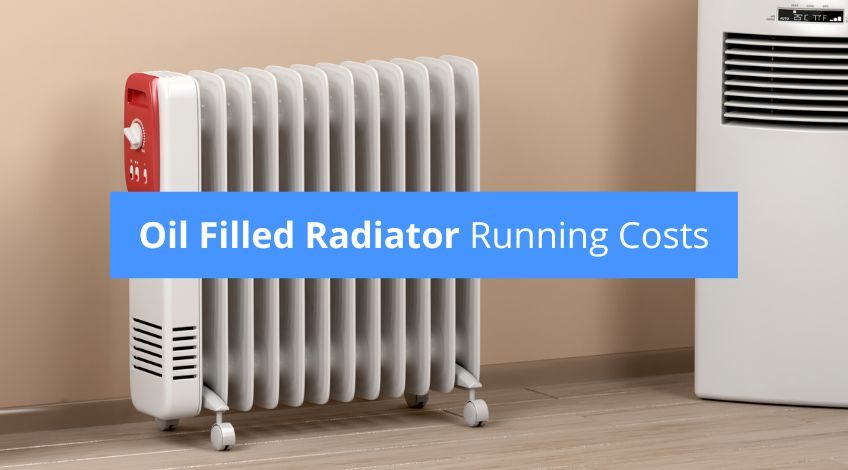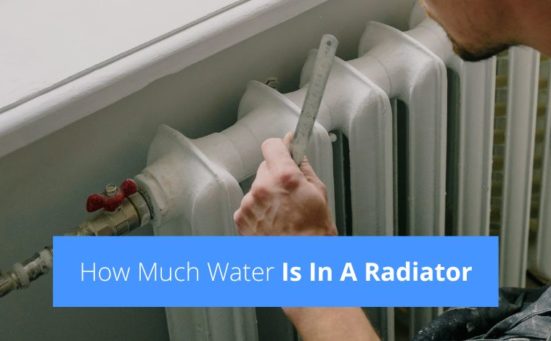 Last Updated: May 2025
Last Updated: May 2025 Oil Filled Radiator Running Costs Explained (are they expensive?)
This article is all about oil filled radiators, which are electrical appliances. Like all electric heaters, oil filled radiators are 100% efficient. Meaning that all the electricity they consume is converted into heat. Let’s look at exactly what an oil filled radiator is.
What Is An Oil Filled Radiator?
An oil filled radiator is a radiator just like the central heating radiators that are connected to the hot water supply. Except it is free standing, portable, runs on electricity and is filled with oil.
How Do Oil Filled Radiators Work?
The heating element heats up the oil inside the radiator which stores the heat and releases it via the radiator’s fins. Although they have oil in them, you never have to refill them with oil and the oil is sealed inside so it will never cause a mess in your home.
As we just said, the heating element heats up the oil inside the radiator which then releases the heat into the room. The heating element maintains the temperature of the oil via a thermostat that cuts the element on and off as needed to keep the oil at a set temperature.
So to calculate the cost of running an oil filled radiator is only ever going to be approximate. This is because it all depends on a number of factors which include;
- The size of the room
- How cold that room is
- The power rating (wattage) of the radiator
- The length of time it’s running
For example it will take far longer for the room to reach the desired temperature if that room is 10 degrees colder than a similarly sized room. Or if the room is extremely large, the radiator has to heat a larger area to achieve that same level of heat.
Interestingly, oil has the ability to absorb a large amount of heat so using an oil filled radiator reduces the amount of energy needed to run the radiator. Which makes these appliances a cost saving appliance compared to other forms of heating.
Once the desired temperature is achieved, the radiator won’t have to use so much power to maintain that temperature. The heating element will kick in only every now and again to keep topping up the heat to maintain the desired temperature.

Calculating The Running Costs Of An Oil Filled Radiator
Once the radiator is switched on, it begins to heat the element which takes full power. If the room is very cold, fairly large, and poorly insulated and the radiator is lower powered, the radiator will be running at full power almost continuously. That’s the worst case scenario, but it’s a good place to make an estimate on the actual cost of running it.
You can calculate the running cost of an oil filled radiator by multiplying the maximum power output of the radiator and the cost per unit of electricity which can be found on your electricity bill. The maximum power output of the radiator will be measured in watts. 1,000 watts is 1KW which is equal to 1 unit of electricity.
For example a 2KW oil filled radiator that is in use for 5 hours per day will use a maximum of 10 units of electricity per day.
2 (KW) X 5 (hours) = 10 (units of electricity)
If you pay 34p per unit for electricity, the maximum cost of running your 2KW radiator for 5 hours per day will be £3.40.
Which means that in the above example of £3.40 per day – running your oil filled radiator would cost around £23.80 per week.
So To Recap
Oil filled radiators are a popular way to heat your home and are used in many countries all around the world. They are more energy efficient than many other forms of heating.
The oil used in the radiator is sealed in and never needs refilling or replacing. The oil is used by the heater to store and radiate heat that is created by an electric element. As oil can absorb huge amounts of heat it takes less energy to run the radiator.
Oil filled radiators have different power ratings (wattage), the higher rated radiators take less time to heat up the same area that lower rated models would take. Obviously, higher rated models cost more to run but in less time. So a higher rated model could actually save on running costs (subject to how large the room is, the level of heat required and how well insulated the room is).
To calculate the running cost you need to multiply the number of hours the radiator is running by its maximum power rating.
Interested in buying an oil filled radiator? Check out our review by clicking here.
Frequently Asked Questions
Oil filled radiators are one of the most efficient forms of heating in an electrical appliance and therefore use less electricity than some other forms of electrical heating appliances.
Oil filled radiators cost less to run than other electrical heating appliances as the oil holds onto heat for longer making less demands for power. As you are only heating the one room they are more energy efficient than heating the whole house.
The cost of running an oil filled radiator in the UK is calculated on the power rating of the radiator multiplied by the cost of electricity per hour. Which means a 2KW radiator with an electricity cost of 20p per unit will cost 40p per hour to use (2 {KW} X 20 {unit of electricity} = 40p).
As with all electric radiators, oil filled radiators are 100% efficient because they convert all of the power into heat.
Oil filled radiators do not need refilling. The oil is sealed in and is used to absorb the heat produced by the element and release that heat into the room. It is effectively a heat reservoir but it never needs to be refilled.
Also, follow us on Pinterest ...




Does the oil rad use the full unit no matter what setting it’s on? Most oil rads come with settings such as low, medium and high, along with a thermostat setting. So is running the rad on low the same cost as running it on high?